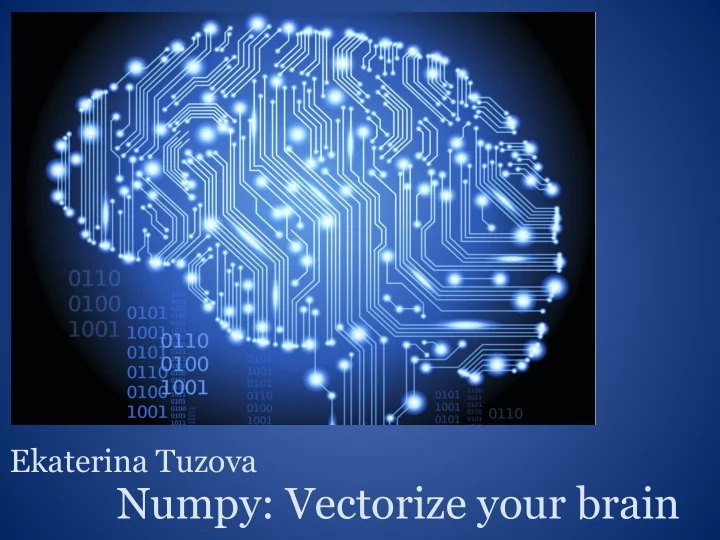

Ekaterina Tuzova Numpy: Vectorize your brain
K nearest neighbors https://archive.ics.uci.edu/ml/datasets/Wine
NumPy
What is NumPy? Numpy is the fundamental package for scientific computing with Python.
IPython
Python and Performance
Python is fast
Python is slow
Euclidian distance
“Magic” timeit
Euclidian distance. C
Euclidian distance. C
Euclidian distance
line_profiler and “magic” lprun
Euclidian distance
Compiled languages
Interpreted languages
What can be done?
NumPy
Ufuncs
U niversal func tions Special type of function defined within a numpy library and it operate element-wise on arrays.
Arithmetic operations
Arithmetic operations
Arithmetic operations
Arithmetic operations
Ufuncs available - Arithmetic - Bitwise - Comparison - Trigonometric - Floating …
Slicing and indexing
Slicing and indexing
Slicing and indexing
Multidimensional arrays
Multidimensional arrays
Index arrays
Index arrays
Index arrays
Masking
Masking
Test train split
Test train split
Broadcasting
Broadcasting Broadcasting describes how NumPy treats arrays with different shapes during arithmetic operations.
Broadcasting rules 1. If two arrays differ in their number of dimension, the shape of the array with the fewer dimensions is padded with ones on it’s leading(left) size. 2. If the shape of two arrays doesn’t match in any dimension, the array with shape equal to 1 in that dimension is stretched to match the other shape. 3. If these conditions are not met, raise a ValueError: operands could not be broadcast together with shapes
Broadcasting. Example
np.newaxis
np.newaxis
np.newaxis
Aggregations
Aggregations
Aggregations
NumPy resume Basic ideas to make you code faster: - Ufuncs - Slicing and indexing - Broadcasting - Aggregations
k-means
Algorithm 1. Clusters the data into k groups where k is predefined. 2. Select k points at random as cluster centers. 3. Assign objects to their closest cluster center according to the Euclidean distance function. 4. Calculate the centroid or mean of all objects in each cluster. 5. Repeat steps 2, 3 and 4 until the same points are assigned to each cluster in consecutive rounds.
Synthetic data
Vectorized euclidian distance
k-means
Thank you. @ktisha
Recommend
More recommend